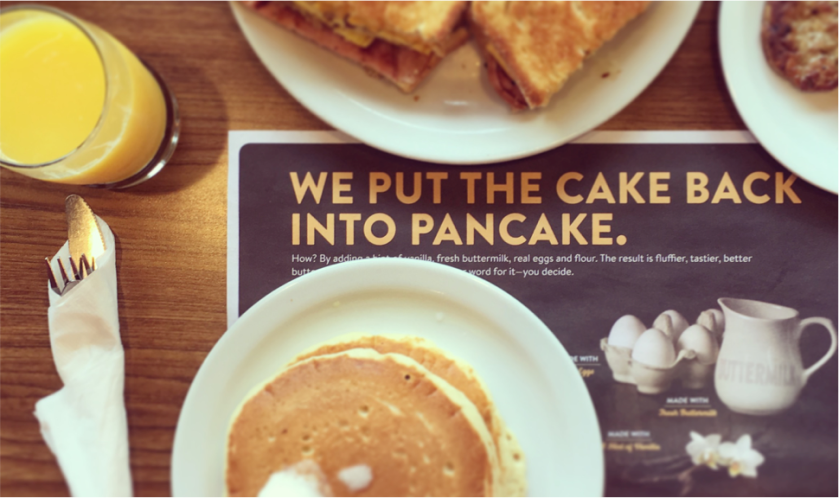Last week, Denny’s served up something new. Seeking to answer the consumer desire for fresher and better tasting products (supposedly led by millennial eaters), America’s Diner switched from stacks of limp, just-add-water pancakes to: “New! Buttermilk pancakes that are made with “good stuff like fresh buttermilk, real eggs, flour and a hint of vanilla.” The result is purportedly “50% fluffier pancakes” that “just might be better than home.”
We’re likely to see many more real-food recipe re-dos as companies seek to reinvent themselves in a changing marketplace. Mark Cotter, CEO of consulting firm The Food Group warns, “If these companies do not modify what they put in their products … these brands will slowly die.”[i] These rebranding efforts endeavor to capitalize upon shifting definitions of cultural concepts like “good food,” “realness,” and “freshness.” These efforts also take on a particular look and feel.
Three years in the making, the Denny’s recipe switch is supplemented by a highly styled aesthetic. It’s a look replete with the overhead shots and grainy wood backgrounds so often grammed, pinned, and tweeted in foodie rituals of digital conspicuous consumption.

From the Denny’s website
Denny’s website also features a food pornographic “Pancake Experience,” which you can (and should) view here. Each of Denny’s new “real” ingredients makes a special appearance in the video loop. The Experience begins with a shot of buttermilk seductively crashing into flour that quickly cuts to a whisk being drawn through thick batter and to a close-up of a pancake on a griddle, plumping to a state of doneness.

From the Denny’s website
In subsequent shots, pancakes fall from above only to bounce with a carb-y springiness into a perfectly positioned pile, before syrup drizzles down the stack.

From the Denny’s website
What does it mean for Denny’s to become a producer of food porn?
Molly O’Neil defined food porn as, “prose and recipes so removed from real life that they cannot be used except as vicarious experience.”[ii] Anne McBride similarly argues that food porn “generally evokes the unattainable” and emphasizes surface appearances.[iii] Gooey, graphic close-ups, sensuous slow pans, and bright-yet-softly-lit shots each frame food with a gaze that both worships and objectifies.
Also typical of food porn is the absence and invisibility of labor, time, and mess. Even when food bloggers include step-by-step recipe instructions and accompanying photographs, they closely control and curate the material processes. As Tisha Dejmanee argues in her study of food blogs, “The result is a cake that seemingly frosts itself, pairing the abundance and excess of food blogs with a seemingly effortless, immaterial productivity.”[iv] Dejmanee rightly argues that this has gendered implications: “In this mode of representation, ‘new’ media adopt ‘old’ values, repeating a long history of erasing the material investments and tedious feminized labor of food preparation.”[v]

The concluding “food porn” shot of Denny’s “Pancake Experience.” Image from the Denny’s website
This visible, but highly compressed depiction of food labor is a food media trend unto itself—like Tasty videos, sub-one-minute clips that depict cooking as blissfully mindless entertainment at warp speed. Produced by Buzzfeed Motion Pictures, Tasty’s Facebook page has nearly 65 million likes and the videos have been viewed billions of times. Dayna Evans quips in New York Magazine that these videos:
tap into the pleasure center of my brain with their mesmerizing simplicity, lack of fussiness, and quick pace. They make cooking seem painless, sedative. In a sea of free-flowing content … Tasty videos act as calming one-minute meditations.
Denny’s achieves a similarly meditative pornification of food and labor in its Pancake Experience. Even if it weren’t on a loop, it’s sure to garner repeat views, which is part of the ongoing debate about food porn and the social work it does, and does not, perform.
In the case of Denny’s, recipe revision and the inclusion of more whole food ingredients are new and laudable steps for a diner franchise to take, but they’re rendered somewhat apolitical by the glossiness of the food porn approach. The consumers who desire “real food”—who marketers are so eager to decode—also seek justice on a plate. “Real” ingredients are just one part of an eating equation that also includes attention to how food is grown, processed, and distributed, as well as to the hands, lives, and experiences of those who craft these ingredients into meals—pancakes or otherwise.
That said, my husband and I put Denny’s pancake-porn-driven rebranding to the test this weekend. We found that the pancakes are indeed fluffy, if a touch undercooked, but still yummy enough that “all you can eat” seemed an exhilarating proposition. And at a value menu price, these are “real” pancakes that many more consumers are likely to be able to afford. Perhaps we shouldn’t dismiss these “real” ingredient makeovers too quickly.
In her plea for culinary modernism, Rachel Laudan encourages us to resist the ahistorical nostalgia of culinary Luddism, which judges every product of the industrial food system as inadequate, morally corrupt, and loathsome. “Real,” “fresh” buttermilk pancakes might be a first, small step toward the high quality, affordable, and just industrial food system that Laudan encourages us to demand.
Could a better industrial food system start somewhere like Denny’s?
Notes
[i] Hadley Malcom, “Meet Denny’s Newest Breakfast Wars Weapon,” USA Today, July 12, 2016.
[ii] Molly O’Neil, “Food Porn,” Columbia Journalism Review, 23 October 2003.
[iii] Anne McBride, “Food Porn,” Gastronomica: The Journal of Food and Culture 10 (2010) 1, 38.
[iv] Tisha Dejmanee, “’Food Porn’ as Postfeminist Play: Digital Femininity and the Female Body on Food Blogs,” Television & New Media (2015), 16.
[v] Dejmanee, 16-17.
